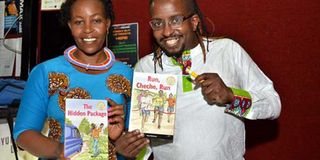3D cinema, theatre meet in Nairobi's coolest book launch

Authors Muthoni wa Gichuru (left) and Tony Mochama pose with their books at iMax Cinema, Nairobi, on Tuesday. PHOTO | FRANCIS NDERITU
What you need to know:
- Cheche Chepchirchir, his main character, is a young runner who discovers a plot by students who called themselves ‘Gang of Six’ to burn down the school. She must deal with this, as well as her quest to be the running champion, the possibility of getting a new stepmother, the impending threat of hyenas and a terrorist recruiter!
- The Hidden Package, on the other hand, tackles the issue of poaching. It follows the story of four friends, Atieno, Njaria, Wamuyu and Wasiwasi, who are on their home way from school when they see a stranger hiding a package inside a bush.
- EAEP Managing Director Kiarie Kamau made a clarion call to young authors to write literary works with contemporary themes so that they could be able to “stand side by side with Ngugi wa Thiong’o.”
It was a double celebration on Tuesday as award-winning Kenyan writers launched their novels at the IMAX Cinema.
Tony Mochama and Muthoni wa Gichuru launched their young-adult novels Run, Cheche, Run and The Hidden Package, respectively.
The two books were published by East African Educational Publishers (EAEP), which prides itself as being home to renowned authors Okot p’Bitek, Ngugi wa Thiong’o, Grace Ogot, Chinua Achebe, Marjorie Oludhe Macgoye and Peter Abrahams, among others.
The books are the 2016 recipients of the Burt Award for African Literature, with The Hidden Package taking the second position and Run, Cheche, Run the third. The winning manuscript in 2015 — Mark Chetambe’s Names and Secrets — was also submitted by EAEP.
The books deal with contemporary issues that affect the country. Run, Cheche, Run was inspired by the unrest in schools and subsequent school fires of 2016.
“I wanted to get into the minds of students to try to understand what made them start the fires, and to also tackle the issue of exams as a catalyst of the fires,” said author Mochama.
The mind that the author gets into is that of Cheche Chepchirchir, his main character, a young runner who discovers a plot by students who called themselves ‘Gang of Six’ to burn down the school. She must deal with this, as well as her quest to be the running champion, the possibility of getting a new stepmother, the impending threat of hyenas and a terrorist recruiter!
The book is infused with the author’s characteristic wit, wicked humour and charming local references that are bound to resonate with the Kenyan reader.
The Hidden Package, on the other hand, tackles the issue of poaching. It follows the story of four friends, Atieno, Njaria, Wamuyu and Wasiwasi, who are on their home way from school when they see a stranger hiding a package inside a bush. Their curiosity gets the better of them and they follow the stranger into the bush, but what they discover there sets off a chain of events that puts them in grave danger.
GOOD STORIES
The author, who grew up in Laikipia where wild animals roamed freely as she herded her father’s goats, watched as their population dwindled due to poaching and this sparked anger in her.
“When I am angry, I write. I wanted to write a book so that my son Gichuru, who is 12, could get something to read every evening. My children are avid readers and buying books can be very expensive.
“In 2015 when I was writing the book, there was a spate of animal poaching and several rhinos and elephants were killed. I knew I wanted to write a mystery so that gave me an idea about what I could write about,” she said.
Like her previous book, Breaking the Silence, this is also characteristically peppered with humour, intrigue, twists and turns that will keep the reader turning the pages.
Mochama decried what he sees as the overuse of classics in the school curriculum instead of contemporary novels that students could easily relate to.
“Why are students reading a book like the The Pearl by John Steinbeck, a book I also read in the nineties while a student, while we have contemporary Kenyan writing that they can relate to?
“We have to give a chance to new books which have contemporary themes.”
So, what stood out in the two authors’ manuscripts to warrant the publisher’s stamp of approval?
“I had a good feeling about the books the minute I received the manuscripts. I am familiar with their previous work and knew both were good writers,” said Lucas Wafula, editorial and literary manager at EAEP.
Addressing the age-old question of what it takes to get published, Mr Wafula said:
“All you need to do as a writer is to write a good story. We only publish stories which are publishable.”
EAEP Managing Director Kiarie Kamau made a clarion call to young authors to write literary works with contemporary themes so that they could be able to “stand side by side with Ngugi wa Thiong’o.”
“We are looking forward to the day when Kenyans will start quoting their local authors instead of Nigerians, Zimbabweans and other foreign writers. It is time to start being proud of our own,” added Wafula.
The launch was fused with music, poetry and theatre performances and a 3D movie to cap it all, in what the organisers described as an effort to make reading look “cool, trendy, interesting and fun” for the younger generation.





